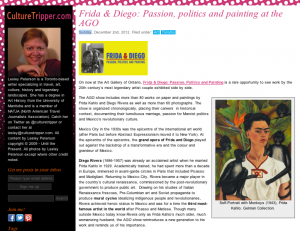Culture Tripper.com

Frida & Diego: Passion, politics and painting at the AGO
On now at the Art Gallery of Ontario, Frida & Diego: Passion, Politics and Painting is a rare opportunity to see work by the 20th century’s most legendary artist couple exhibited side by side.
The AGO show includes more than 80 works on paper and paintings by Frida Kahlo and Diego Rivera as well as more than 60 photographs. The show is organized chronologically, placing their careers in historical context, documenting their tumultuous marriage, passion for Marxist politics and Mexico’s revolutionary culture.
Mexico City in the 1930s was the epicentre of the international art world (after Paris but before Abstract Expressionism moved it to New York). At the epicentre of the epicentre, the grand opera of Frida and Diego played out against the backdrop of a transformative era and the colour and grandeur of Mexico.
Diego Rivera (1886-1957) was already an acclaimed artist when he married Frida Kahlo in 1929. Academically trained, he had spent more than a decade in Europe, immersed in avant-garde circles in Paris that included Picasso and Modigliani. Returning to Mexico City, Rivera became a major player in the country’s cultural renaissance, commissioned by the post-revolutionary government to produce public art. Drawing on his studies of Italian Renaissance frescoes, Pre-Columbian art and Soviet propaganda to producemural cycles idealizing indigenous people and revolutionaries, Rivera achieved heroic status in Mexico and was for a time the third most-famous artist in the world after Picasso and Matisse. Though many outside Mexico today know Rivera only as Frida Kahlo’s much older, much womanizing husband, the AGO show reintroduces a new generation to his work and reminds us of his importance.
Frida Kahlo (1907-1954) was a very bright student, one of only 35 female pupils out of 2000 at Mexico’s best educational institution, the National Preparatory School. A horrific bus accident at 18 shattered her spine and pelvis and derailed her intended career as a doctor, making her instead a lifelong medical patient. Bedridden for long periods of time, often immobilized in body casts, Frida took up painting, mostly self-portraits that explored her identity and inner world. Sixty years after her death at age 47, Frida Kahlo’s paintings still glow like jewels, testimony to her painstaking technique and scrupulous brush care.
A year after I saw Frida’s work displayed alongside that of Emily Carr and Georgia O’Keeffe at the McMichael, the movie Frida (2002) was released. Snowballing attention, fueled by Hayden Herrera’s definitive biography, helped vault Frida to cult status. Today she is celebrated not only for her oeuvre but for her zest for life and as a symbol of the creative spirit thriving despite physical and psychological pain.

